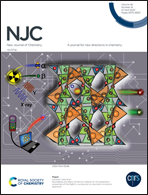Regulating the proton conductivity of metal organic framework materials through solvent control†
Abstract
In order to study the influence of different solvent molecules on the proton conductivities of MOFs, {[Zn(pyeb)2](DMF)(H2O)}n (1) (PyebH = 4-[2-(4-pyridyl)vinyl)]-benzoic acid, DMF denotes N,N′-dimethylformamide) was selected and synthesized due to different solvent molecules in the crystal structure. It possesses a 3D rhombic framework and exhibits outstanding thermal stabilities. In order to study the relationship between the different solvent molecules and proton conductivity properties, on the basis of MOF 1, three MOFs with different solvent molecules were obtained by introducing acetonitrile, acetone and DMF, denoted as {[Zn(pyeb)2](MeCN)}n (2), {[Zn(pyeb)2](Me2CO)}n (3), and {[Zn(pyeb)2](DMF)}n (4). Through further research, it is found that the proton conductivities of the four MOFs are closely related to the solvent guest molecules in the pores, indicating that the change of solvent molecules can regulate the proton conductivity. This research work has certain significance in the detection of solvents by electrochemical probes.



 Please wait while we load your content...
Please wait while we load your content...